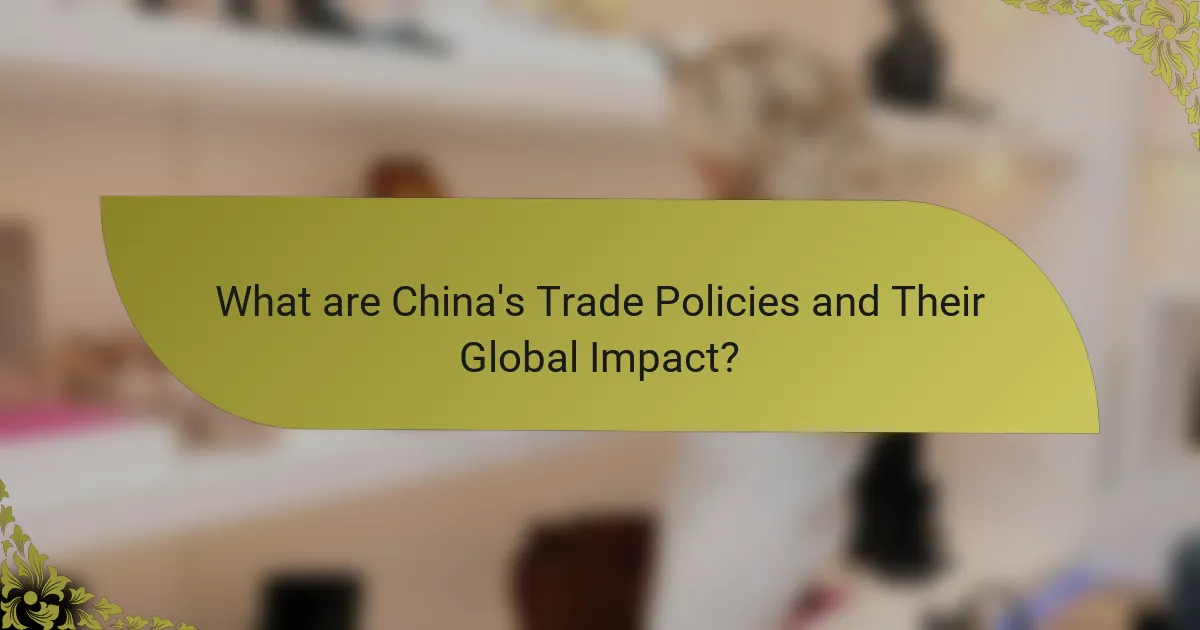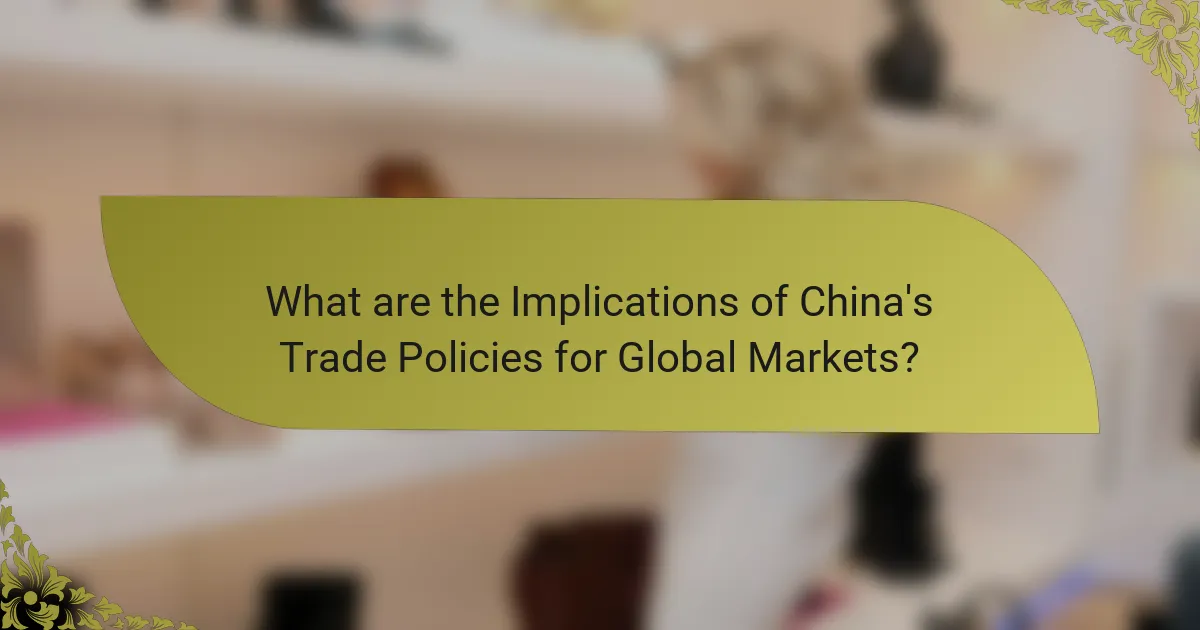China’s trade policies are centered on export-driven growth, tariff adjustments, and strategic trade agreements, which aim to enhance its economic development and global market presence. The country employs tariffs to protect domestic industries while pursuing negotiations to improve market access, exemplified by initiatives like the Belt and Road Initiative. Recent shifts toward greater openness, including reduced tariffs on numerous products and active participation in regional agreements such as the Regional Comprehensive Economic Partnership (RCEP), reflect China’s strategy to integrate more deeply into the global economy. These policies significantly influence international supply chains, commodity prices, and trade dynamics, impacting over 120 countries that consider China their largest trading partner. The evolving emphasis on technology transfer and intellectual property rights further underscores China’s role in shaping the global economic landscape.

What are China’s Trade Policies and Their Global Impact?
China’s trade policies focus on export-driven growth, tariff adjustments, and trade agreements. These policies aim to boost economic development and increase global market presence. China employs tariffs to protect domestic industries while engaging in trade negotiations to enhance market access. The Belt and Road Initiative exemplifies China’s strategy to expand trade routes and partnerships.
These policies significantly impact global markets. For instance, China’s trade practices influence supply chains and commodity prices worldwide. In 2021, China was the largest trading partner for over 120 countries, demonstrating its global trade influence. Additionally, trade tensions with countries like the United States have led to shifts in global trade dynamics.
China’s emphasis on technology and innovation in trade policies has also reshaped sectors like electronics and manufacturing. As a result, countries must navigate these changes to adapt to evolving global trade patterns.
How do China’s trade policies influence global markets?
China’s trade policies significantly influence global markets by shaping trade flows and economic relationships. These policies include tariffs, import quotas, and export restrictions. For instance, China’s tariff adjustments can lead to increased prices for imported goods worldwide. In 2018, the U.S. imposed tariffs on $250 billion of Chinese goods, which resulted in retaliatory tariffs from China. This trade war affected global supply chains and led to market volatility. Additionally, China’s Belt and Road Initiative promotes infrastructure investment in participating countries, enhancing trade connectivity. Overall, China’s trade policies create ripple effects that impact global economic dynamics.
What are the key components of China’s trade policies?
China’s trade policies are characterized by several key components. These include import tariffs, export subsidies, and trade agreements. Import tariffs are used to protect domestic industries by making foreign goods more expensive. Export subsidies encourage local companies to sell products abroad by reducing their costs. Trade agreements with various countries aim to enhance market access for Chinese goods. Additionally, China’s policies often emphasize the Belt and Road Initiative, promoting infrastructure development and connectivity. These components collectively shape China’s position in global trade and influence international market dynamics.
How do these policies affect international trade dynamics?
China’s trade policies significantly influence international trade dynamics. They shape global supply chains and market access. For instance, tariffs and quotas can restrict imports from other countries. This leads to increased costs for foreign exporters. Additionally, China’s trade agreements can create preferential access for partner nations. As a result, trade flows may shift towards countries with favorable agreements. China’s state-led economic model also impacts competition. It can create an uneven playing field for foreign companies. The World Trade Organization (WTO) reports that these policies can lead to trade tensions and retaliatory measures. Such dynamics reshape the global trading landscape.
Why have China’s trade policies changed recently?
China’s trade policies have changed recently due to economic pressures and geopolitical tensions. The country aims to boost domestic consumption and reduce reliance on exports. This shift is influenced by slowing economic growth and a desire for self-sufficiency. Additionally, trade disputes with the United States have prompted China to diversify its trade partners. Recent reforms focus on improving trade relations with ASEAN and other emerging markets. These changes are also a response to global supply chain disruptions caused by the COVID-19 pandemic. Overall, China’s trade policy adjustments reflect a strategic move towards resilience and sustainability in its economy.
What economic factors are driving changes in China’s trade policies?
China’s trade policies are primarily driven by economic factors such as domestic economic growth, global trade tensions, and shifts in supply chain dynamics. The Chinese government aims to sustain economic growth by enhancing exports and attracting foreign investments. Trade tensions, especially with the United States, have prompted China to diversify its trade partnerships. Additionally, the COVID-19 pandemic has accelerated shifts in supply chains, leading China to adapt its trade policies to maintain competitiveness. The need for technological advancement and self-sufficiency also influences policy changes, as China seeks to reduce reliance on foreign technology. These factors collectively shape China’s evolving trade landscape.
How do geopolitical considerations shape these policies?
Geopolitical considerations significantly shape China’s trade policies. These policies often reflect China’s strategic interests in securing resources and expanding its influence. For instance, the Belt and Road Initiative exemplifies how China aims to enhance connectivity and trade routes. This initiative is also a means to counter Western dominance in global trade. Additionally, China’s trade policies are influenced by its relationships with neighboring countries and major powers. Economic partnerships are often forged to strengthen political alliances. Furthermore, trade policies may be adjusted in response to sanctions or trade disputes, particularly with the United States. Historical context reveals that trade has been a tool for geopolitical leverage. Overall, geopolitical factors are integral to understanding the motivations behind China’s trade policies.

What Key Changes Have Occurred in China’s Trade Policies?
China’s trade policies have shifted significantly in recent years. The country has moved towards greater openness and reduced tariffs. In 2019, China announced a reduction of tariffs on over 850 products. This change aims to enhance foreign investment and boost imports. Additionally, China has been actively participating in regional trade agreements. The Regional Comprehensive Economic Partnership (RCEP) is a notable example, signed in November 2020. These adjustments reflect China’s strategy to integrate more deeply into the global economy. Furthermore, the emphasis on technology transfer and intellectual property rights has evolved. China is now focusing on protecting its innovations while fostering international collaboration.
What specific changes have been implemented in recent years?
China has implemented several significant changes to its trade policies in recent years. These include the introduction of tariffs on various imports, aimed at protecting domestic industries. Additionally, China has revised its export regulations to enhance the quality of goods. The nation has also engaged in trade agreements with multiple countries to strengthen economic ties. Furthermore, China has shifted its focus towards promoting high-tech industries through subsidies and support. According to the World Trade Organization, these changes reflect China’s adaptation to global economic shifts. The adjustments have implications for global supply chains and market dynamics.
How have tariffs and trade agreements evolved?
Tariffs and trade agreements have evolved significantly over the past century. Initially, tariffs were used primarily to protect domestic industries. The Smoot-Hawley Tariff Act of 1930 raised tariffs to unprecedented levels, leading to retaliatory measures from other countries. Post-World War II, the General Agreement on Tariffs and Trade (GATT) was established to promote international trade through reduced tariffs. In recent decades, trade agreements like NAFTA and the TPP have emerged, emphasizing free trade and economic integration. China’s entry into the World Trade Organization (WTO) in 2001 marked a pivotal shift, increasing global trade interdependence. Today, tariffs are often used as tools in trade negotiations, reflecting geopolitical tensions and economic strategies.
What role does technology play in these changes?
Technology plays a crucial role in the changes brought about by China’s trade policies. It enhances supply chain efficiency and reduces costs for businesses. Advanced technologies like artificial intelligence and big data analytics enable better decision-making. Automation in manufacturing increases productivity and competitiveness. Moreover, technology facilitates international trade by streamlining logistics and communication. The rise of e-commerce platforms allows Chinese goods to reach global markets more effectively. According to a 2020 report by McKinsey, digital technologies could add $1.2 trillion to China’s economy by 2025. Thus, technology significantly influences the dynamics of global trade in the context of China’s evolving policies.
How do these changes impact global supply chains?
Changes in China’s trade policies significantly impact global supply chains. These policies affect tariffs, import quotas, and export restrictions. For instance, increased tariffs on goods can raise costs for manufacturers worldwide. This leads to higher prices for consumers and reduced demand.
Moreover, stricter regulations on imports can disrupt supply chains by causing delays. Companies may face challenges in sourcing raw materials. This can result in production slowdowns and inventory shortages.
Additionally, shifts in trade agreements can alter trade routes. This impacts logistics and transportation costs. A study by the World Bank highlights that trade policy changes can lead to a 10% increase in shipping costs.
Overall, these changes create uncertainty in global markets. Businesses must adapt to navigate the evolving landscape.
What industries are most affected by China’s trade policy changes?
The industries most affected by China’s trade policy changes include technology, agriculture, and manufacturing. Technology companies face tariffs and restrictions on imports and exports. These changes impact supply chains and market access. Agriculture is affected due to tariffs on exports, particularly soybeans and pork. Manufacturing industries experience shifts in production costs and competitiveness. The automotive sector sees changes in tariffs affecting both imports and exports. Additionally, textiles and apparel face challenges from altered trade agreements. These shifts influence global market dynamics significantly.
How do businesses adapt to these new trade dynamics?
Businesses adapt to new trade dynamics by diversifying supply chains. This strategy mitigates risks associated with reliance on a single market or supplier. Companies are increasingly sourcing materials from multiple countries. They also invest in technology to enhance logistics and inventory management. Additionally, businesses analyze trade policies to identify opportunities and threats. This helps them adjust pricing strategies and product offerings. Moreover, firms engage in local partnerships to strengthen market presence. These adaptations are essential for maintaining competitiveness in a rapidly changing global landscape.

What are the Implications of China’s Trade Policies for Global Markets?
China’s trade policies significantly impact global markets. These policies influence international supply chains and trade balances. For instance, China’s tariffs can affect the prices of goods worldwide. Additionally, its regulations on imports and exports can lead to market volatility. China’s Belt and Road Initiative expands its trade influence, altering global economic dynamics. In 2020, China’s exports accounted for 14.7% of global exports. This percentage reflects its critical role in global trade. Trade tensions can also lead to shifts in alliances among countries. Overall, China’s trade policies are pivotal in shaping the global economic landscape.
How do China’s trade policies affect global economic stability?
China’s trade policies significantly impact global economic stability. These policies influence international supply chains and trade balances. For instance, China’s tariffs and import quotas can disrupt global markets. In 2018, the U.S.-China trade war led to increased tariffs, affecting global trade volumes. This resulted in fluctuations in commodity prices and supply chain disruptions worldwide. Moreover, China’s currency manipulation has raised concerns among trading partners. Such actions can lead to economic imbalances and uncertainty in global markets. Consequently, China’s trade policies are critical in shaping the economic landscape for other nations.
What potential risks arise from China’s trade strategies?
China’s trade strategies pose several potential risks. These include increased global trade tensions and retaliatory tariffs. The reliance on a single market can lead to economic vulnerabilities. Supply chain disruptions can occur due to geopolitical conflicts. Intellectual property theft remains a significant concern for foreign companies. Additionally, China’s market access restrictions can hinder foreign investment. Economic coercion may be used as a tool against other nations. These risks can destabilize global markets and impact economic growth.
How might these policies influence global inflation rates?
China’s trade policies can significantly influence global inflation rates. By adjusting tariffs and trade agreements, China impacts the cost of goods worldwide. Higher tariffs on imports can lead to increased prices for consumers. This can create inflationary pressure in other countries reliant on Chinese goods. Conversely, lower tariffs may reduce costs and help stabilize prices globally. Historical data shows that changes in China’s trade policies often correlate with shifts in inflation rates in various economies. For example, the U.S.-China trade war resulted in increased consumer prices in the United States. Thus, China’s trade decisions directly affect global inflation dynamics.
What opportunities do China’s trade policies create for other countries?
China’s trade policies create opportunities for other countries by facilitating access to its vast market. These policies often include lower tariffs and trade agreements that enhance exports. For example, the Belt and Road Initiative encourages infrastructure investments in partner countries. This initiative opens channels for trade and economic cooperation. Countries can benefit from increased foreign direct investment from Chinese firms. Additionally, collaboration in technology and innovation is promoted through trade partnerships. The rise of e-commerce platforms in China allows foreign businesses to reach Chinese consumers more easily. Overall, China’s trade policies foster economic growth and integration for participating nations.
Which regions stand to benefit from China’s trade shifts?
Southeast Asian countries, particularly Vietnam and Thailand, stand to benefit from China’s trade shifts. These nations are increasingly becoming alternative manufacturing hubs. As businesses seek to diversify supply chains, they are moving production to these regions. Vietnam’s GDP growth has been bolstered by an influx of foreign direct investment. Thailand is also enhancing its export capabilities through trade agreements. Both countries are strategically positioned to capture market share in the wake of China’s evolving trade landscape. This shift is further supported by their competitive labor costs and improving infrastructure.
How can countries leverage these changes for economic growth?
Countries can leverage changes in China’s trade policies for economic growth by enhancing their export strategies. By identifying new markets in China, countries can increase demand for their goods. Adjusting trade agreements to benefit from reduced tariffs can also stimulate exports. Additionally, investing in technology and innovation can improve product competitiveness. Collaborating with Chinese firms can lead to shared resources and knowledge. Countries can also diversify supply chains to reduce dependency on single markets. Utilizing trade data analytics helps in making informed decisions. These strategies can lead to increased GDP and job creation.
What strategies can businesses adopt to navigate China’s trade policies?
Businesses can adopt several strategies to navigate China’s trade policies effectively. Understanding the regulatory environment is crucial. Companies should invest in local expertise to interpret policies accurately. Building strong relationships with local government officials can facilitate smoother operations. Diversifying supply chains mitigates risks associated with trade restrictions. Utilizing Free Trade Zones can offer tax benefits and reduced tariffs. Engaging in compliance training ensures adherence to local laws. Regularly monitoring policy changes helps businesses stay proactive. Collaborating with local partners can enhance market entry and expansion opportunities.
How can companies assess risks associated with these policies?
Companies can assess risks associated with China’s trade policies by conducting thorough market analysis. This involves evaluating changes in tariffs, quotas, and regulations. Companies should monitor economic indicators that reflect trade dynamics. Analyzing competitor responses provides insights into potential market shifts. Engaging with local experts can offer contextual understanding of policy implications. Utilizing scenario planning helps anticipate various outcomes based on policy changes. Historical data on trade impacts can guide risk assessments. Regularly updating risk assessments ensures responsiveness to evolving trade landscapes.
What best practices should businesses follow to adapt effectively?
Businesses should implement agile methodologies to adapt effectively. Agile practices enhance flexibility and responsiveness to market changes. Regularly assessing market trends is crucial for identifying shifts in consumer behavior. Establishing strong communication channels within teams fosters collaboration and quick decision-making. Investing in technology can streamline operations and improve data analysis capabilities. Building a diverse supply chain mitigates risks associated with reliance on a single source. Continuous employee training ensures that staff remain skilled and adaptable. Lastly, engaging with stakeholders provides insights that inform strategic adjustments. These practices enable businesses to navigate the complexities of changing trade policies and market dynamics.
The main entity of this article is China’s trade policies and their impact on global markets. The article examines the key components of China’s trade strategies, including tariffs, trade agreements, and initiatives like the Belt and Road Initiative, while highlighting their influence on international economic dynamics. It discusses recent changes in these policies driven by economic pressures and geopolitical tensions, and analyzes how these shifts affect global supply chains, inflation rates, and opportunities for other countries. The implications of these policies for global economic stability and the adaptability of businesses in response to the evolving trade landscape are also explored.



